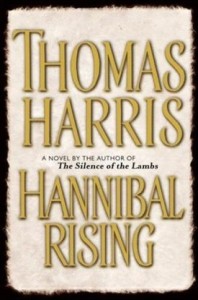 About every ten years, Thomas Harris publishes a book. In 2006, he had ready for publication the fourth novel in the Dr. Lecter series: Hannibal Rising. This book explains the origins of Dr. Lecter’s brutal behaviour and cannibalism, themes that were wildly and successfully used in Red Dragon (1981), The Silence of the Lambs (1988), and Hannibal (1999).
About every ten years, Thomas Harris publishes a book. In 2006, he had ready for publication the fourth novel in the Dr. Lecter series: Hannibal Rising. This book explains the origins of Dr. Lecter’s brutal behaviour and cannibalism, themes that were wildly and successfully used in Red Dragon (1981), The Silence of the Lambs (1988), and Hannibal (1999).
Apparently, Harris did not really want to write Hannibal Rising but was eventually talked into writing it by Dino De Laurentiis, the film director who owned the rights to the Hannibal franchise. Thomas Harris’s reluctance to continue the series is clearly seen between the covers of the book. Although, in the end, everything wraps up nicely, the writing is rushed and the readers have the feeling that they’re not reading a book, but rather a movie script. Which might as well be true, as Thomas Harris himself wrote the script for the 2007 movie adaptation of the novel (starring French actor Gaspard Ulliel in Hannibal’s role).
Hannibal Rising follows Hannibal’s privileged childhood in his father’s castle in Lithuania and the changes the country went through during and immediately after the Second World War when the Soviets took over. It was during the winter of 1944 that Hannibal’s parents are killed and his beloved sister, Mischa, becomes food for a bunch of former Lithuanian militiamen. Gradually, as the story develops and Hannibal starts to remember that winter, we realize that Hannibal himself was fed his own sister.
After his uncle takes Hannibal under his protective wing and brings him to France, he immediately becomes attached to his step mother, Lady Murasaki, a Japanese woman whose family was affected by the atomic bomb dropped by the Americans on Hiroshima. To make space for an unfulfilled romantic relationship between Hannibal and Murasaki (played by Chine actress Gong Li!), the author gets rid of the uncle earlier on in the novel.
Hannibal’s violent attack on a butcher who insulted Lady Murasaki attracts the attention of Inspector Popil, a French detective who is also after criminals of war who were not prosecuted at Nuremburg. Little by little, Hannibal, now a medical student in France, finds all the surviving former militiamen who cannibalized his sister and brutally kills them.
Although the short chapters and the unappealing prose are somewhat of a disappointment, Thomas Harris’s constant references to art and the Japanese culture make Hannibal Rising a readable thriller. Actually, it is by tracking his family’s stolen art that Hannibal finds his sister’s murderers, while Lady Murasaki initiates him in the art of ikebana, haiku writing, and “sword playing.”
It is worth mentioning that the name of Hannibal’s aunt, Murasaki Shikibu, is in fact that of an 11th century Japanese novelist, author of The Tale of Genji, the world’s earliest novel. Also, Lady Murasaki’s maid of honor has a cousin in Hiroshima, who turns out to be none other than Sadako Sasaki, the heroine of the One Thousand Paper Cranes legend, for whom they fold origami birds. And, of course, Miyamoto Musashi’s name could not have been left out in a book where the main character uses Japanese swords to revenge his family and do justice for past wrongdoings.
It is difficult not to sympathize with the young Hannibal Lecter, whose life as a cannibal started on the Eastern Front of WWII, where he lost his immediate family. Hannibal Rising ends with Lecter going to America where he had been offered a residency at Johns Hopkins Hospital in Baltimore, where he would become the famous psychiatrist and serial killer known as “Hannibal the Cannibal.”
Check out Thomas Harris’s website too.
